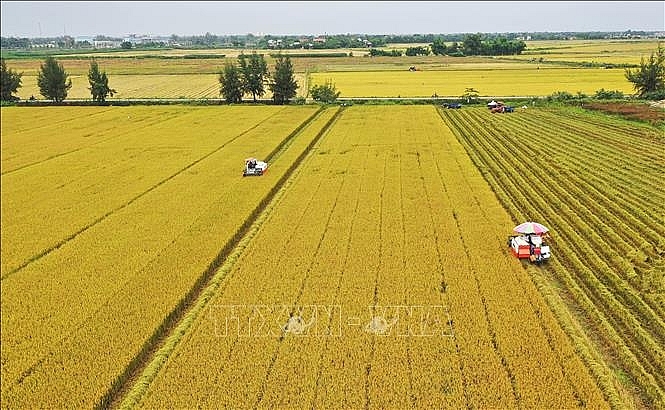Tax exemptions encouraging agricultural growth
 |
| Tax exemptions encouraging agricultural growth, illustration photo, VNA |
Minister of Finance Dinh Tien Dung has presented a draft resolution on the expansion of agricultural land use tax exemptions until 2025, following a similar move applied over the past 20 years, at different five-year periods.
If the legislature passes the resolution, scheduled for June 10, total exempted tax for agricultural land usage will be about VND7.5 trillion ($326 million) per year.
“This would encourage the development of the agricultural sector via tax, helping concentrate land to promote agriculture, applying technology, and moving economic structure and labour in the rural areas,” said Minister Dung. “More jobs will be created, reducing the amount of labour working in other localities or overseas while increasing income for rural labour and contributing to the new rural area-building programme.”
As a foreign company, Dutch group De Heus is not allowed to own land and is not carrying out any commercial farming activities. However, the company’s general director in Vietnam and Cambodia, Johan Van Den Ban, believed the tax move is a great decision. “A big part of our customers’ growth depends on the availability of land where they can conduct their livestock activities. The decision, of course indirectly, is good for De Heus as a feed company as well,” Ban said.
Along with De Heus, all agricultural companies including Nafoods Group can benefit from the decision. “We own 200 hectares of farming land, with 4,400ha on contract with farms and households, so it will be a great amount of tax. Therefore, the tax exemption expansion allows us and farmers to concentrate on our business, widening facilities, and applying technologies,” Nguyen Manh Hung, general director of Nafoods, told VIR. According to Hung, his company aims to gain VND1.35 trillion ($58.7 million) of revenues and VND66 billion ($2.87 million) of after-tax profit in 2020. “We identify that we must be active in market, materials, and finance. The market is opening while the EU-Vietnam Free Trade Agreement is also about to come into effect. This is the chance for us,” he said.
Nguyen Duc Hai, Chairman of the National Assembly’s Financial and Budgetary Committe, said that the policy of exempting tax to use agricultural land has been a catalyst to attract an increasing number of big companies to invest in agriculture in the past, developing high-quality agricultural products.
“Along with large-scale investment, using a large number of labourers in difficult economic areas, agricultural enterprises have promoted applying science and technology to improve product quality,” Hai said. “The initial results have affirmed that the Party and state’s policies, including tax exemption, is right.”
According to data from the Ministry of Finance, about 50,000 firms operating in the whole country are investing in agriculture. However, only 10,200 ones directly invest in producing items for agriculture, forestry, and fisheries, 96 per cent of which are small- and micro-sized enterprises.
According to the government’s socio-economic report for 2001-2010, the implementation of the tax exemption since the beginning of the century has partly helped increased agricultural production value by 4.2 per cent per year. The sector’s export turnover also increased from $4.7 billion to $19.15 billion in the period. Last year, the export value of agriculture, forestry, and fisheries reached $41.3 billion.
Meanwhile, according to the General Statistics Office, from 2011-2016 the exempted tax value to agricultural land was VND6.3 trillion ($273.9 million) per year while the value of 2016-2020 hit about VND9.7 trillion ($421.7 million). “This is an essential support for organisations and individuals producing agriculture, and an important source of finance to invest and widen agricultural manufacturing,” Minister Dung said, adding that tax exemptions on using agricultural land aim to create a favourable investment environment, attract capital, and quicken the country’s modernisation progress.
Currently Vietnam has 8.6 million farmer households.
What the stars mean:
★ Poor ★ ★ Promising ★★★ Good ★★★★ Very good ★★★★★ Exceptional
Related Contents
Latest News
More News
- Ho Chi Minh City backs $2 billion AI data centre with dedicated task force (January 06, 2026 | 08:43)
- PM sets January deadline for high-speed rail consultant (January 06, 2026 | 08:40)
- New decree spurs on PPP implementation (December 31, 2025 | 19:01)
- Global alliance develops $1 billion AI data centre network in Vietnam (December 30, 2025 | 10:08)
- Standing out in the Chinese outbound investment wave (December 29, 2025 | 10:29)
- Bright spots obvious in foreign investment mission (December 29, 2025 | 09:00)
- Ho Chi Minh City hits $8.37 billion in FDI (December 29, 2025 | 08:28)
- Vietnam and UK cooperation backs finance talent for IFCs (December 27, 2025 | 16:31)
- Global partnerships key to Vietnam’s IFC development (December 26, 2025 | 16:18)
- Vingroup pulls out of bid to invest in North-South high-speed railway (December 26, 2025 | 11:42)

 Tag:
Tag:





















 Mobile Version
Mobile Version